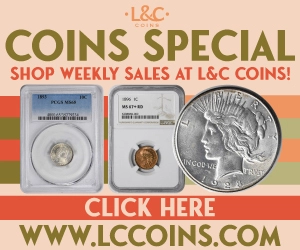By Al Doyle for CoinWeek …..
It happens to every collector, and often on a repeated basis.
An exciting coin comes along – imagine a $5 gold Indian at close to melt value, an 1891-CC Morgan dollar in a CAC, PCGS or NGC EF-45 holder, or a circulated 1807 Draped Bust half cent with appealing chocolate brown surfaces – and the funds aren’t available. Why do those opportunities always arrive when the wallet is empty?
The obvious answer is to have some money available for such encounters. Easier said than done? Probably. However, with some planning and a simple and sound collecting strategy, the lower-budget collector can use a savings method and have the cash needed to obtain better quality goods with some frequency.
Having More Coins That You Want Means Buying Fewer Coins
So, how can those on a budget maximize their coin collecting? The first step is to have fewer coins. Sound contradictory?
Anyone who has been around numismatics for a while owns several impulsive or unwise purchases that are gathering dust. It doesn’t matter what possessed a person to buy that BU roll of 1961-D Jefferson nickels or 1978 Bahamas Proof Set, but it’s a good idea to flush the misfits out of a collection.
Likely, many of these past purchases now bring less than what you paid but look at the red ink as tuition in the school of coin collecting. Purging stuff that doesn’t fit and getting something for it isn’t the worst scenario. Sometimes, you’ll break even or come out a bit ahead. If the items in question are bullion-related and purchased more than a few years ago, then you could be on the winning side of the ledger.
Make a Purchasing Plan… and Stick to It
Save the proceeds on something other than the first round and shiny object that comes along. Have a specific coin or two in mind or a plan to get the most value for the money spent. Think quality, not quantity. The word “quality” doesn’t necessarily mean the highest-priced options in the marketplace.
“There’s stuff, and then there’s real coins,” declares one wise coin shop owner with over 30 years in the business. Even with its luster and lack of bag marks, an MS-64 1921 Morgan dollar falls into this dealer’s “stuff” category, as would an MS-69 American Silver Eagle.
On the other hand, a Seated Liberty dime or quarter from the 1840s in Very Fine or a scarcer-date Shield nickel in a similar grade makes the “real coin” list.
How can that happen when the type coins are often less expensive than high-grade items? Despite their relatively modest values, the older circulated coins with original surfaces can be hard to locate. The “stuff vs. real coins” game can be played at all price levels.
Selling Your Castoffs Is Easy
Unloading surplus coins should be easy to do. Your unwanted coins can always be sold or consigned to a dealer, offered on eBay, or placed on a bid board at coin shops. Coin clubs sometimes hold auctions where members sell coins; one-on-one transactions at club meetings are also common. Merchandise needs to be honestly graded and priced. Don’t take advantage of newbies who have little knowledge.
Other unwanted or forgotten things may be doing nothing but taking up space around the house. Anything from selling one or two surplus objects to a weekend garage sale can provide cash and reduce clutter. If you have too much to process by yourself, enlist family members. They will gladly help, assuming you offer them a fair share of the profits.
What happens when the excess material has been sold, and the proceeds have been turned into better quality items? The quality of your collection improves. This is a proven and painless way to save cash for hobby-related purchases that make for some budget-friendly coin collecting.
Save a Little Each Day… It Will Make Your Next Coin Purchase More Rewarding
Even those on the lower economic scale handle numerous $1 bills over a month. Setting aside one or more singles at a time will soon result in a pile of Washingtons. If the pile gets too thick (some problem!), exchange the $1s for a larger bill and keep stacking.
In addition to building a fund for coin buying, the $1 savings plan provides positive reinforcement and visual proof of progress. While this method won’t offer the capital needed to obtain a 1916-D Mercury dime or a $20 gold Saint-Gaudens, it is easy to accumulate $100 to $500 in six months or less. This strategy is worth doing even if you don’t have a specific coin in mind. Why?
Carry the money you have saved to the next large coin show in your area. If you don’t find something you want to purchase at a convention such as Baltimore, FUN, Central States, or ANA, then you don’t have much of a numismatic eye. But if you are like most experienced collectors, surrounded by all kinds of coins that capture the eyes, you’ll have the money to take action and build a better collection.
* * *
